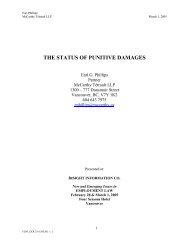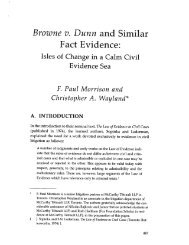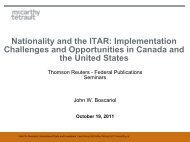The Doctrine of Public Policy in Canadian Contract Law
The Doctrine of Public Policy in Canadian Contract Law
The Doctrine of Public Policy in Canadian Contract Law
You also want an ePaper? Increase the reach of your titles
YUMPU automatically turns print PDFs into web optimized ePapers that Google loves.
<strong>The</strong> <strong>Doctr<strong>in</strong>e</strong> <strong>of</strong> <strong>Public</strong> <strong>Policy</strong> <strong>in</strong> <strong>Canadian</strong> <strong>Contract</strong> <strong>Law</strong> 1 15<br />
III. THE CATEGORIES OF PUBLIC POLICY<br />
1. Statutory Illegality, Common <strong>Law</strong> Illegality and <strong>Public</strong> <strong>Policy</strong><br />
Certa<strong>in</strong> courts and commentators are <strong>in</strong> the habit <strong>of</strong> treat<strong>in</strong>g "illegality"<br />
and public policy as a s<strong>in</strong>gle concept, and will <strong>of</strong>ten <strong>in</strong>clude the former with<strong>in</strong><br />
the various categories <strong>of</strong> the latter. 73 Other authorities, while acknowledg<strong>in</strong>g a<br />
dist<strong>in</strong>ction between "statutory" and "common law" illegality, assert that contracts<br />
which are contrary to public policy comprise a class <strong>of</strong> agreements that<br />
are "illegal" at common law (<strong>in</strong> the same way that, e.g., a contract to commit a<br />
tort upon a third party is "illegal").74 Nevertheless, it is submitted that the most<br />
accurate taxonomy is a tripartite division consist<strong>in</strong>g <strong>of</strong> the follow<strong>in</strong>g: (1) statutory<br />
illegality; (2) common law illegality; and (3) public policy.75<br />
<strong>Contract</strong>s can fall under the head<strong>in</strong>g <strong>of</strong> statutory illegality <strong>in</strong> various<br />
ways.76 <strong>The</strong>y may be expressly or impliedly prohibited by statute, or be entered<br />
<strong>in</strong>to with the object <strong>of</strong> committ<strong>in</strong>g an act prohibited by statute, or require the<br />
<strong>in</strong>cidental performance <strong>of</strong> an act contrary to statute, or have the capacity to<br />
confer benefits through the violation <strong>of</strong> a statute.77 <strong>Contract</strong>s which fall under<br />
the head<strong>in</strong>g <strong>of</strong> common law illegality also <strong>in</strong>volve the contravention <strong>of</strong> a legal<br />
obligation, although the obligations <strong>in</strong> question are those imposed by tortious<br />
73 See, <strong>in</strong> this connection, Chitty, supra note 6 at para. 16-005. This practice was criticized<br />
<strong>in</strong> Nepean Hydro-Electric Commission v. Ontario Hydro, [1982] 1 S.C.R. 347, 1982<br />
CarswellOnt 116 at para. 39, where the Court accepted the view that: "[u]nlawful' and<br />
`illegal' are generally used as synonymous terms, but a dist<strong>in</strong>ction is occasionally drawn<br />
between them; 'unlawful,' as applied to promises, agreements, considerations and the<br />
like, is sometimes used to denote that they are <strong>in</strong>effectual <strong>in</strong> law because they <strong>in</strong>volve<br />
acts which, although not illegal (that is to say, positively forbidden), are disapproved <strong>of</strong><br />
by the law, and are therefore not recognised as a ground <strong>of</strong> legal rights, either because<br />
they are immoral, or because they are aga<strong>in</strong>st public policy... It is on this ground that<br />
contracts <strong>in</strong> restra<strong>in</strong>t <strong>of</strong> marriage or <strong>of</strong> trade are generally void." For a semantically<br />
opposite position, where the Court l<strong>in</strong>ked public policy to "illegality" rather than "unlawfulness",<br />
see Cont<strong>in</strong>ental Bank <strong>of</strong> Canada v. R., (sub nom. Cont<strong>in</strong>ental Bank Leas<strong>in</strong>g<br />
Corp. v. Canada), [1998] 2 S.C.R. 298, [1998] S.C.J. No. 63 at paras. 114-117.<br />
74 This is the approach taken by Fridman, supra note 5, and Waddams, supra note 4.<br />
75 This division appears to be the one contemplated <strong>in</strong> Halsbury's <strong>Law</strong>s <strong>of</strong> England, 4th ed.<br />
(Reissue), Vol. 9(1) (London: Butterworths, 1998) at para. 836 [Halsbury's].<br />
76 For a comprehensive discussion <strong>of</strong> the various ways <strong>in</strong> which contracts may result <strong>in</strong> an<br />
illegality or a contravention <strong>of</strong> public policy, see M.P. Furmston, "<strong>The</strong> Analysis <strong>of</strong> Illegal<br />
<strong>Contract</strong>s" (1965-66) 16 U. Tor. L.J. 267.<br />
77 See generally: St. John Shipp<strong>in</strong>g Corp. v. Joseph Rank Ltd., [1957] 1 Q.B. 267 (Eng.<br />
Q.B.); Still v. M<strong>in</strong>ister <strong>of</strong> National Revenue (1997), [1998] 1 F.C. 549, [1997] F.C.J. No.<br />
1622 (C.A.); and Oldfield v. Transamerica Life Insurance Co. <strong>of</strong> Canada, 2002 SCC 22.<br />
A contract may also be <strong>in</strong>valid on the ground that it <strong>in</strong>volves the contravention <strong>of</strong> a judicial<br />
order: see Hadfield v. Hadfield (1996), 1996 CarswellBC 2819, [1996] B.C.J. No. 2583<br />
(B.C. S.C.) at para. 11, hold<strong>in</strong>g void an agreement which contemplated the contravention<br />
<strong>of</strong> a bail order.
















